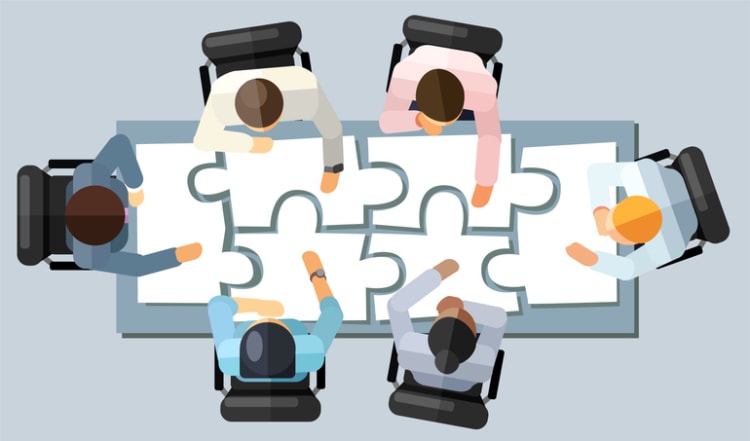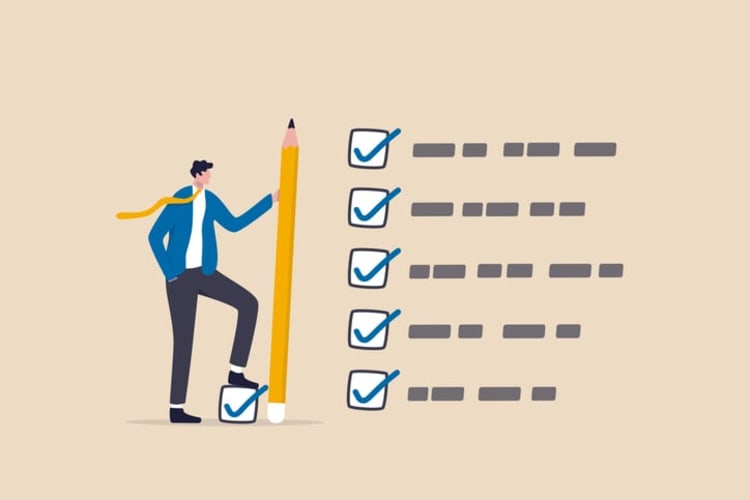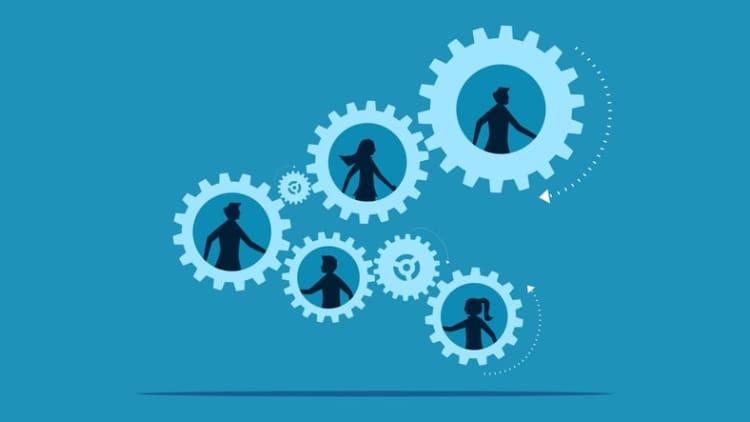Choosing the right ‘type of meetings’ can be the linchpin for effective teamwork and progress. Do you need to brainstorm, plan, decide, or bond with your team? This guide will provide clear definitions and uses for each meeting type, ensuring you have the tools to host successful gatherings that enhance collaboration and drive results.
Key takeaways
- Determine the necessity and type of meeting required, aiming for efficiency and productivity with attention to timing, participant roles, and meeting format.
- Cultivate creativity and collaboration through diverse brainstorming sessions and empower decision-making with well-informed, prepared participants, focusing on reaching consensus.
- Close meetings effectively by summarizing, making decisions clear, providing direction, and delegating tasks to ensure concrete next steps and enhance overall meeting success.
Navigating the world of business meetings

Let’s begin with a comprehension of the different types of business meetings that shape the corporate landscape. Each meeting serves a unique purpose, from fostering team collaboration and strengthening relationships to driving project progression. The aim is to ensure that these meetings add value to you and your team, helping you become a better participant and run meetings effectively.
It’s important to assess the necessity of a meeting before scheduling it. Could the information be relayed via email? If not, choose the type of meeting that best serves your intended purpose. Understanding different types of meetings is the first step towards effortless organization and productivity.
Inefficient meetings are a common issue in business today, with professionals spending approximately 2 hours each week in pointless meetings. This is often due to the wrong kind of meeting being run or the right meeting being run in the wrong way. It’s time to navigate the world of business meetings and make them work for you.
Let’s examine the core components of kickoff, brainstorming, and decision-making meetings in more detail.
The essentials of kickoff meetings
Kickoff meetings are more than a simple get-together. They are the cornerstone that paves the way for a successful project. These meetings outline the game plan and facilitate introductions among team members, setting the stage for a seamless start.
The key to a successful kickoff meeting is timing. These meetings should be scheduled before any work on the project begins to set the right tone and ensure everyone is aligned and ready to hit the ground running.
Kickoff meetings empower every individual to understand their roles and responsibilities, setting the project on a path to a successful outcome right from the beginning. Let’s examine how to optimize these meetings for a confident project kick-start.
The art of effective brainstorming sessions
Brainstorming sessions are the incubators of creativity and innovation within a business environment. They offer a platform for team members to come together and generate new ideas or solutions, fostering innovation and creative thinking to overcome specific challenges.
Diversity is the secret sauce of an effective brainstorming session. When you bring together individuals with diverse perspectives, the brainstorming session becomes a powerhouse for:
- generating better ideas
- identifying potential blind spots
- creating innovative solutions
- fostering a relaxed and supportive environment
The key to effective brainstorming meetings is to create the right environment. Here are some tips to help you:
- Encourage out-of-the-box thinking
- Utilize techniques such as mind mapping
- Maintain an informal environment
- Give enough time for idea exploration without stifling enthusiasm
By following these tips, you can make your brainstorming meetings more productive and creative, ensuring the brainstorming meetings number remains manageable.
Get ready for a brainstorming session that can open up new possibilities and stimulate creativity in your team.
Decision-making meetings: reaching consensus
Decision-making meetings are the pulse of an organization. They focus on considering various options and selecting the best one while ensuring fairness and equanimity. It’s important to distinguish decision-making meetings from problem-solving meetings. The latter focuses on searching for good options without necessarily making a final choice.
The participants of a decision-making meeting are influential decision-makers, subject matter experts, and advisors. To make a significant contribution, attendees should be well-informed and thoroughly prepared for the discussion.
A typical decision-making meeting:
- Aims for a duration of 30 minutes to 1 hour
- Ideally involves between 5 to 15 participants for the most effective results
- If a consensus isn’t reached within 60 minutes, it’s time to consider a vote or a decision by the key leader.
Next, we’ll examine the details of creating an effective meeting agenda.
Crafting the perfect meeting agenda

A well-prepared meeting agenda includes:
- Purpose and goals
- Participants and their roles
- Topics and their timeframes
- Meeting format and logistics
- Preparation and action items
This comprehensive outline helps run a successful meeting that aligns with the team’s needs and provides a clear direction for discussions.
Creating an effective meeting agenda involves:
- Including items that reflect the team’s needs and asking for their input.
- Clearly defining the meeting goals and being as specific as possible.
- Allocating specific time slots for each topic and ensuring that every agenda item contributes to achieving the meeting’s goal.
Next, we’ll look into the realm of team-building meetings, focusing on the team-building meetings number and the role of a team member.
Building cohesion with team building meetings

Team building meetings are the glue that binds coworkers together. They encourage team members to engage in collaborative activities that enhance teamwork, foster strong connections and cooperation within the team, and ultimately strengthen relationships among members.
To take your team to the next level, the most effective team-building activities are those that are challenging yet fun. These activities, like solving puzzles together or having a show and tell, are designed to open channels of communication and foster a strong sense of camaraderie. Let’s delve into how team lunches and retreats can enhance these connections.
Team lunches and retreats: strengthening bonds
Team lunches and retreats are more than just a fun day out. They are carefully planned activities aimed at fostering strong bonds within your team. These activities involve all team members in the planning process, creating a sense of ownership and commitment.
Creating an unforgettable team lunch or retreat doesn’t always require extravagant planning. Simple outdoor outings or in-person gatherings where people can relax and connect on a more personal level can have a profound impact on team dynamics. From ice-breaker games to shared meals and outdoor adventures, the possibilities for bonding activities during team retreats are endless. Including family members in fun activities can also create a stronger sense of belonging and camaraderie among team members.
Next, we’ll investigate the foundational element of project management: planning meetings.
Project management's cornerstone: planning meetings

Planning meetings are the bedrock of successful project management. They bring all stakeholders together, gather information, and decide on a project’s scope. The outcome is a solid plan for the project that aligns the team and keeps them motivated by sharing their achievements from previous quarters.
Active collaboration is key in planning meetings. Participants are expected to contribute to the work product, establishing relationships and understanding how each person can contribute. These meetings are usually led by the project owner or a skilled facilitator, such as a project manager.
The art of conducting effective planning meetings lies in their design. They are structured to learn anything that can improve the plan. Depending on the project size, these meetings can span several sessions over weeks or even months.
Now, let’s examine the mechanics of a problem-solving meeting and problem-solving meetings.
The dynamics of problem-solving meetings

Problem-solving meetings are the think tanks of an organization. They provide a platform to discuss challenges head-on and find the best solutions. To boost productivity during problem-solving meetings, discussions should focus on team accomplishments, individual member priorities, and actions required to achieve shared objectives. Typically, the supervisor takes the lead in facilitating the meeting.
Avoiding pitfalls such as poorly handled updates and surprises that can derail the agenda is crucial to ensure the meetings successfully track progress. Next, let’s investigate how governance meetings help in defining roles and responsibilities.
Governance meetings: clarifying roles and responsibilities

Governance meetings are the steering wheel of an organization. They are highly structured meetings with a predetermined agenda that is shared in advance and recorded to prevent surprises. Their purpose is to supercharge collaboration, facilitate decision-making, and set constraints that support the achievement of the organization’s objectives.
To elevate your governance meetings, follow these steps:
- Prepare the meetings in advance.
- Timebox the meetings between 90-120 minutes for optimal results.
- Schedule these power-packed meetings every 2-4 weeks to keep the momentum going with regular check-ins and updates.
Governance meetings are effective in clarifying team roles and responsibilities. They:
- Outline goals
- Determine tasks
- Identify gaps
- Use tools like the RACI matrix for clarity
- Allow for valuable feedback from team members
- Ensure regular review and updates of roles and responsibilities.
Next, let’s look at the significance of one-on-one meetings in personal development and feedback.
One-on-one encounters: personal development and feedback

One-on-one meetings are the building blocks of personal development. They offer a valuable opportunity for managers and employees to delve into long-term and short-term goals, share experiences, and articulate their requirements for ongoing development.
To make your one-on-one meetings truly effective, follow these steps:
- Take charge and set the agenda yourself.
- The focus should be on you doing most of the talking, while your manager listens and provides feedback.
- Keep operational topics to a minimum, but if there’s something urgent, it can be addressed towards the end, if time allows.
By following these steps, you can ensure that your one-on-one meetings are productive and focused.
Avoiding pitfalls such as managers dominating the conversation, employees complaining about coworkers, and managers making empty promises can ensure productive and effective one-on-one meetings.
Next, we’ll discuss status update meetings and their function in tracking progress.
The pulse of progress: status update meetings

Status update meetings are the pulse of progress in an organization. These meetings, led by managers, are focused on staying on top of project progress and sharing vital information with stakeholders. This promotes transparency and ensures accountability for project success.
In a status update meeting, you should focus on what the team is excelling at, individual member priorities, and actions required to achieve shared objectives. Avoid pitfalls such as poorly handled updates and surprises that can derail the agenda to ensure the meetings successfully track progress.
Next, let’s explore the realm of virtual meetings for distributed teams.
Virtual gatherings: leveraging online meetings for remote teams

Virtual meetings are the lifeline of remote teams. They offer incredible advantages such as cost and commute time reduction, along with enhanced scheduling flexibility. But most importantly, they keep remote teams connected and engaged. Remote teams can conduct team-building activities effectively by organizing engaging virtual team-building exercises that ensure no members of distributed teams are excluded. This helps maintain company culture and morale by connecting employees to their team and organization.
Award-winning platforms like Kumospace are ideal for hosting virtual meetings. Kumospace offers immersive virtual environments, seamless video chat, and efficient meeting management software. It helps teams establish ground rules for success and makes virtual collaboration a breeze.
Moreover, Kumospace is designed to enhance team meetings in a virtual environment. With its innovative spatial audio and video features, Kumospace recreates the dynamics of an in-person meeting, allowing team members to interact seamlessly. The platform's spatial layout enables participants to move within a virtual space, fostering natural conversations and spontaneous interactions, much like walking around a physical office. This unique approach enhances engagement and collaboration, making Kumospace a valuable tool for virtual team meetings where the aim is to recreate the dynamics of in-person interactions. Next, let’s delve into the specifics of board meetings and executive sessions.

The broad view: board meetings and executive sessions
Board meetings are the heart of a company’s strategic planning. These meetings bring together the Board of Directors, elected by a company’s shareholders, to oversee and guide the organization’s performance. They discuss high-level strategic topics, such as:
- launching new products
- expanding into new markets
- setting financial goals
- evaluating performance metrics
These discussions are crucial for the company’s progress.
A typical board meeting includes the following steps:
- Call to order
- Approve the agenda
- Approve prior meeting minutes
- Foster active participation
- Encourage group discussion
- Leverage member expertise
- Stick to the predetermined agenda
- Stay within a set timeframe.
Now, let’s talk about the influence of check-in meetings.
The power of check-in meetings

Check-in meetings are the heartbeats of a team’s progress. They drive progress and foster alignment through active group participation, setting them apart from traditional status update meetings. Check-in meetings provide an opportunity for team members to:
- Voice their feelings and opinions without fear, fostering a psychologically safe environment
- Share updates on their work and progress
- Discuss any challenges or roadblocks they are facing
- Seek support or input from other team members
- Celebrate successes and achievements
Team meetings play a crucial role in fostering team collaboration and maintaining productivity in today’s dynamic work environment.
To make the most of check-in meetings, focus on team accomplishments, individual member priorities, and actions required to achieve shared objectives. By keeping everyone informed about upcoming events or deadlines and focusing on finding solutions rather than dwelling on complaints, you can ensure productive check-in meetings.
Next, let’s discuss the function of an innovation meeting in igniting creativity and pushing projects forward, as well as the role of innovation meetings in general.
Innovation meetings: sparking creativity and advancing projects

Innovation meetings are the catalyst of creativity in a business environment. They are designed to inspire participants to tap into their collective creativity and move forward with a newfound focus and confidence. Kumospace is the perfect tool to elevate your innovation meetings, offering immersive virtual environments, seamless video chat, and efficient meeting management software. With the added benefit of helping teams establish ground rules for success, it’s time to take your virtual collaboration to the next level.
To fuel inspiration and innovation during meetings, consider:
- Setting clear goals
- Preparing and sharing the agenda
- Using creative techniques and tools
- Encouraging participation and feedback
- Inviting diverse participants
- Creating a safe space for sharing ideas
- Embracing failure as a learning opportunity
Next, let’s consider the impact of retrospective meetings.
Reflecting on success: the role of retrospective meetings

Retrospective meetings are a mirror to past projects. They provide an opportunity for teams to reflect on their work and identify opportunities for process improvements. To make your retrospective meetings effective, focus on discussing important topics such as:
- working relationships
- interactions
- processes
- tools
To ensure these meetings are solution-oriented, host well-structured sessions.
A typical retrospective meeting aims for a dynamic group of 3-15 participants and a focused duration of 1 to 2 hours. This ensures that the meetings are both comprehensive and efficient. Next, let’s discuss all-hands meetings and their function in involving the entire team.
All-hands on deck: engaging the entire team

All-hands meetings are an opportunity to:
- Reconnect with the entire team
- Foster unity and collaboration among all employees, including leadership
- Have open communication flow between everyone and the leadership
These meetings are closely linked to town hall meetings.
To make your all-hands meetings truly impactful, break them down into sections and steer clear of inside jokes that might isolate certain team members. This will ensure that everyone feels included and valued.
The approximate duration for all-hands meetings ranges from 30 minutes to 2 hours, giving you the perfect opportunity to engage and align your team. All-hands meetings are a superior choice over emails as they prevent issues with tone and delivery and provide a platform for immediate live feedback and questions through a Q&A session.
Next, let’s discuss onboarding meetings and their significance for new employees.
Preparing newcomers: the importance of onboarding meetings

Onboarding meetings are the first step in a new hire’s journey. They are where managers ignite the potential of new hires, guiding them to seamlessly blend into the team. To make your onboarding meetings effective, ensure that the newcomer has the chance to voice their feelings and opinions without fear, thereby creating a psychologically safe environment. Remember, the focus should be on the newcomer doing most of the talking, while the manager listens and provides feedback.
Work buddy meetings are a crucial part of the onboarding process. They not only help new employees learn about the company’s procedures but also connect them with existing employees. These meetings can lead to not just professional integration but also to the development of meaningful friendships, setting new employees up for success.
Next, let’s conclude with effective meeting closures.
The final call: wrapping up with effective meeting closures

An effective meeting closure is the key to a successful meeting. It provides clarity, sets direction, summarizes discussions, makes clear decisions, and establishes concrete steps forward.
Mastering the art of delegation during meeting closures is crucial for effective management. Here are some steps to follow:
- Establish a clear communication channel.
- Clarify individual and team goals.
- Distribute work across team members.
- Communicate expectations.
- Provide clear instructions and authority to delegate responsibilities effectively.
By closing a meeting effectively, you can:
- Provide clarity
- Set direction
- Summarize discussions
- Make clear decisions
- Establish concrete steps forward
This ultimately boosts the overall effectiveness of the meeting.
Now, let’s sum up what we’ve learned.
Summary
We’ve taken a deep dive into the world of meetings, exploring their various types and purposes. We’ve learned how to navigate business meetings, craft effective agendas, build team cohesion, manage projects, solve problems, clarify roles in governance meetings, and engage in one-on-one encounters. We’ve also reflected on the importance of status updates, virtual gatherings, board meetings, check-ins, innovation meetings, retrospectives, all-hands encounters, onboarding sessions, and effective meeting closures.
The link between all of the aforementioned steps to planning a meeting, as well as the various types of meetings themselves, is they can all be completed on Kumospace. Kumospace is the leader for virtual workspaces and makes it so meetings are seamless, engaging, and efficient.
Remember, meetings are not just about sitting in a room; they are about engaging, innovating, and driving success. By understanding and mastering the different types of meetings, you can supercharge your team’s collaboration and productivity. Let’s turn our meetings into powerhouses of productivity.
Frequently asked questions
Running a good meeting involves knowing the Purpose, Product, People, and Process (agenda) beforehand. Share this information with the meeting participants at the start of the meeting to ensure productivity.
The three types of review meetings are operational, strategic, and strategy renewal. These meetings help to assess different aspects of the business and plan for the future.
In teams, you can have different types of meetings, including regular meetings, webinars, town halls, calls, onboarding meetings, one-on-one meetings, check-in meetings, brainstorming meetings, all-hands meetings, decision-making meetings, problem-solving meetings, quarterly planning meetings, board meetings, and live events. Consider the meeting elements before choosing the type that best suits your needs.
In conclusion, a brainstorming session focuses on generating new ideas and fostering innovation, while a problem-solving meeting is about discussing challenges and finding the best solutions. Both are essential for addressing specific issues successfully.
Make your onboarding meetings more effective by creating a psychologically safe environment where newcomers feel comfortable expressing their thoughts and opinions. This will help foster a positive and open atmosphere during the onboarding process.
What do you mean? An African or a European swallow?





